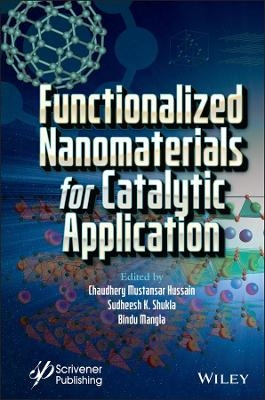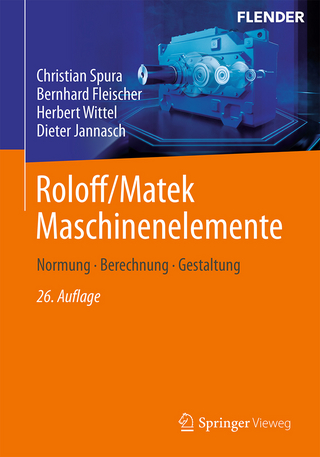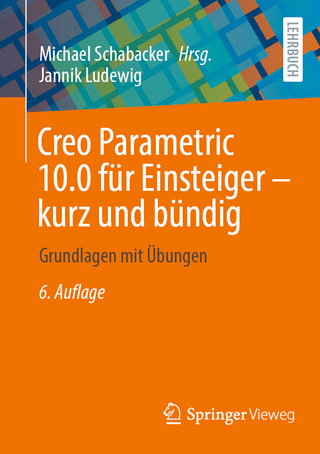
Functionalized Nanomaterials for Catalytic Application
Wiley-Scrivener (Verlag)
978-1-119-80897-8 (ISBN)
With the rapid development in nanotechnology, it is now possible to modulate the physical and chemical properties of nanomaterials with molecular recognition and catalytic functional applications. Such research efforts have resulted in a huge number of catalytic platforms for a broad range of analytes ranging from metal ions, small molecules, ionic liquid and nucleic acids down to proteins. Functionalized nanomaterials (FNMs) have important applications in the environmental, energy and healthcare sectors. Strategies for the synthesis of FNMs have contributed immensely to the textile, construction, cosmetics, biomedical and environmental industries among others.
This book highlights the design of functionalized nanomaterials with respect to recent progress in the industrial arena and their respective applications. It presents an inclusive overview encapsulating FNMs and their applications to give the reader a systematic and coherent picture of nearly all relevant up-to-date advancements. Herein, functionalization techniques and processes are presented to enhance nanomaterials that can substantially affect the performance of procedures already in use and can deliver exciting consumer products to match the current lifestyle of modern society.
Chaudhery Mustansar Hussain, PhD is an adjunct professor, academic advisor and Lab Director in the Department of Chemistry & Environmental Sciences at the New Jersey Institute of Technology (NJIT), Newark, New Jersey, USA. His research is focused on the applications of nanotechnology & advanced materials in environment, analytical chemistry and various industries. Dr. Hussain is the author of numerous papers in peer-reviewed journals as well as a prolific author and editor of many scientific monographs and handbooks in his research areas. Sudheesh K. Shukla, PhD is a postdoctoral researcher at Shandong University China. His research work focuses on interfacing the chemistry (materials science) and engineering for better healthcare (biology) and environmental applications. Dr. Shukla has extensive experience in materials science (materials design, synthesis and characterization), nanocomposite synthesis, nanobiotechnology, catalysis science and biosensors/sensors. Bindu Mangla is an assistant professor in the Department of Chemistry, J C Bose University of Science & Technology, YMCA, Faridabad (Hr), India. She completed her PhD in Chemistry, from Manav Rachna International Institute of Research and Studies (erstwhile MRIU). She has a keen research interest in the area of materials chemistry, nanotechnology, corrosion chemistry and atmospheric chemistry.
Preface xvii
1 Functionalized Nanomaterial (FNM)–Based Catalytic Materials for Water Resources 1
Sreevidya S., Kirtana Sankara Subramanian, Yokraj Katre, Ajaya Kumar Singh and Jai Singh
1.1 Introduction 4
1.2 Electrocatalysts as FNMs 7
1.3 Electro-Fenton/Hetero Electro-Fenton as FNMs 8
1.4 Hetero Photo-Fenton as FNMs 13
1.4.1 Heterogenous-Fentons-Based FNMs 14
1.4.2 Photo-Fentons-Based FNMs 14
1.5 Photocatalysts as FMNs 19
1.5.1 Carbon-Based FNMs as Photocatalysts 24
1.5.1.1 CNT-Based FNMs 24
1.5.1.2 Fullerene-Based FNMs 25
1.5.1.3 Graphene (G)/Graphene Oxide (GO)–Based FNMs 26
1.5.1.4 Graphene-Carbon Nitride/Metal or Metalloid Oxide–Based FNMs 27
1.5.1.5 Graphene-Carbon Nitride/QD-Based FNMs 28
1.5.2 Polymer Composite–Based FNMs as Photocatalyst 29
1.5.3 Metal/Metal Oxide–Based FNMs as Photocatalyst 29
1.6 Nanocatalyst Antimicrobials as FNMs 30
1.7 Conclusions and Future Perspectives 31
References 33
2 Functionalized Nanomaterial (FNM)–Based Catalytic Materials for Energy Industry 53
Amarpreet K. Bhatia, Shippi Dewangan, Ajaya K. Singh and Sónia. A.C. Carabineiro
2.1 Introduction 54
2.2 Different Types of Nanomaterials 55
2.2.1 Zero-Dimensional (0D) Nanostructures 55
2.2.2 One-Dimensional (1D) Nanostructures 56
2.2.3 Two-Dimensional (2D) Nanostructures 56
2.2.4 Three-Dimensional (3D) Nanostructures 56
2.3 Synthesis of Functionalized Nanomaterials 56
2.3.1 Chemical Methods 57
2.3.2 Ligand Exchange Process 58
2.3.3 Grafting of Synthetic Polymers 58
2.3.4 Miscellaneous Methods 58
2.4 Magnetic Nanoparticles 59
2.4.1 Synthesis of Magnetic Nanoparticles 59
2.4.2 Characterization of Magnetic Nanoparticles 60
2.4.3 Functionalization of Magnetic Nanoparticles 63
2.4.3.1 Covalent Bond Formation 64
2.4.3.2 Ligand Exchange 64
2.4.3.3 Click Reaction 64
2.4.3.4 Maleimide Coupling 65
2.5 Carbon-Based Nanomaterials 65
2.5.1 Functionalization of Carbon Nanomaterials 65
2.5.2 Synthesis of Functionalized Carbon Nanotubes and Graphene 67
2.6 Application of Functionalized Nanomaterials in the Energy Industry Through Removal of Heavy Metals by Adsorption 67
2.6.1 Removal of Arsenic by Magnetic Nanoparticles 74
2.6.2 Removal of Cadmium by Magnetic Nanoparticles 75
2.6.3 Removal of Chromium by Magnetic Nanoparticles 75
2.6.4 Removal of Mercury by Magnetic Nanoparticles 76
2.7 Conclusions 76
References 77
3 Bionanotechnology-Based Nanopesticide Application in Crop Protection Systems 89
Abhisek Saha
3.1 Introduction 90
3.2 Few Words About Pesticide 92
3.3 What About Biopesticide Demand 93
3.4 A Brief Look on Associates Responsible for Crop Loss 93
3.5 Traditional Inclination of Chemical-Based Pest Management 94
3.6 Nanotechnology in the Field of Agriculture 95
3.7 Why Nanotechnology-Based Agriculture is the Better Option With Special Reference to Nano-Based Pesticide? 95
3.8 Biological-Based Pest Management 96
3.9 Nano-Based Pest Management 96
3.10 Nanopesticides 97
3.11 Required to Qualify for Selection as Nanobiopesticides 98
3.12 Pestiferous Insect’s Management 99
3.12.1 Chemical Nanomaterials 99
3.12.2 Bionanomaterials 99
3.13 Critical Points for Nanobiopesticides 100
3.14 Other Pests 100
3.15 Post-Harvest Management and Their Consequences 101
3.16 Field Test for Nanobiopesticides for Pest Control 101
3.17 Merits and Consequences of Chemical and Bionanomaterials 102
3.18 Conclusion 103
References 104
4 Functionalized Nanomaterials (FNMs) for Environmental Applications 109
Bhavya M.B., Swarnalata Swain, Prangya Bhol, Sudesh Yadav, Ali Altaee, Manav Saxena, Pramila K. Misra and Akshaya K. Samal
4.1 Introduction 110
4.1.1 Methods for the Functionalization of Nanomaterials 110
4.1.1.1 Functionalization by Organic Moieties 111
4.1.1.2 Surface Polymerization 111
4.1.2 Nanomaterial-Functional Group Bonding Type 112
4.1.2.1 Functionalization by Covalent Bond 112
4.1.2.2 Functionalization by Noncovalent Bond 112
4.2 Functionalized Nanomaterials in Environmental Applications 114
4.2.1 Chitosan 114
4.2.2 Cellulose 117
4.2.3 Alumina 121
4.2.4 Mixed Composites 124
4.2.5 Other Nanocomposites for Environment 126
4.3 Conclusion 130
Acknowledgements 130
References 130
5 Synthesis of Functionalized Nanomaterial (FNM)–Based Catalytic Materials 135
Swarnalata Swain, Prangya Bhol, M.B. Bhavya, Sudesh Yadav, Ali Altaee, Manav Saxena, Pramila K. Misra and Akshaya K. Samal
5.1 Introduction 136
5.2 Methods Followed for Fabrication of FNMs 137
5.2.1 Co-Precipitation Method 138
5.2.2 Impregnation 139
5.2.3 Ion Exchange 139
5.2.4 Immobilization/Encapsulation 140
5.2.5 Sol-Gel Technique 140
5.2.6 Chemical Vapor Deposition 141
5.2.7 Microemulsion 141
5.2.8 Hydrothermal 142
5.2.9 Thermal Decomposition 142
5.3 Functionalized Nanomaterials 143
5.3.1 Carbon-Based FNMs 143
5.3.1.1 Carbon-Based FNMs as Heterogeneous Catalysts 145
5.3.2 Metal and Metal Oxide–Based FNMs 147
5.3.2.1 Functionalization Technique of Metal Oxides 147
5.3.2.2 Silver-Based FNMs as Heterogeneous Catalysts 148
5.3.2.3 Platinum-Based FNMs as Heterogeneous Catalysts 150
5.3.2.4 Pd-Based FNMs as Heterogeneous Catalysts 153
5.3.2.5 Zirconia-Based FNMs as Heterogeneous Catalysts 153
5.3.3 Biomaterial-Based FNMs 154
5.3.3.1 Chitosan/Cellulose-Based FNMs as Heterogeneous Catalysts 155
5.3.4 FNMs for Various Other Applications 156
5.3.5 Comparison Table 157
5.4 Conclusion 158
Acknowledgements 159
References 159
6 Functionalized Nanomaterials for Catalytic Applications—Silica and Iron Oxide 169
Deepali Ahluwalia, Sachin Kumar, Sudhir G. Warkar and Anil Kumar
6.1 Introduction 169
6.2 Silicon Dioxide or Silica 171
6.2.1 General 171
6.2.2 Synthesis of Silica Nanoparticles 172
6.2.2.1 Sol-Gel Method 172
6.2.2.2 Microemulsion 172
6.2.3 Functionalization of Silica Nanoparticles 174
6.2.4 Applications 176
6.2.4.1 Epoxidation of Geraniol 176
6.2.4.2 Epoxidation of Styrene 177
6.3 Iron Oxide 177
6.3.1 General 177
6.3.2 Synthesis of Functionalized Fe NPs 178
6.3.2.1 Biopolymer-Based Synthesis 178
6.3.2.2 Plant Extract–Based Synthesis 179
6.3.3 Applications 179
6.3.3.1 Degradation of Dyes 179
6.3.3.2 Wastewater Treatment 181
References 182
7 Nanotechnology for Detection and Removal of Heavy Metals From Contaminated Water 185
Neha Rani Bhagat and Arup Giri
7.1 Introduction 186
7.2 History of Nanotechnology 186
7.3 Heavy Metal Detective Nanotechnology 187
7.3.1 Nanotechnology for Arsenic (Aas) Removal 187
7.3.2 Nanotechnology for Lead Removal from Water 197
7.3.3 Nanotechnology for Cadmium (Cd) Removal from Water 200
7.3.4 Nanotechnology for Nickel (Ni) Removal 200
7.4 Futuristic Research 209
7.5 Conclusion 209
References 210
8 Nanomaterials in Animal Health and Livestock Products 227
Devi Gopinath, Gauri Jairath and Gorakh Mal
8.1 Introduction 228
8.2 Nanomaterials 230
8.3 Nanomaterials and Animal Health 230
8.3.1 Role in Disease Diagnostics 230
8.3.2 Role in Drug Delivery Systems 232
8.3.3 Role in Therapeutics 232
8.3.4 Toxicity and Risks 233
8.4 Nanomaterials and Livestock Produce 234
8.4.1 Nanomaterials and Product Processing 234
8.4.1.1 Nanoencapsulation 235
8.4.2 Nanomaterials and Sensory Attributes 239
8.4.3 Nanomaterials and Packaging 239
8.4.3.1 Nanocomposite 240
8.4.3.2 Nanosensors 241
8.4.4 Safety and Regulations 241
8.5 Conclusion 243
References 243
9 Restoring Quality and Sustainability Through Functionalized Nanocatalytic Processes 251
Nitika Thakur and Bindu Mangla
9.1 Introduction 252
9.1.1 Nanotechnology Toward Attaining Global Sustainability 252
9.2 Nano Approach Toward Upgrading Strategies of Water Treatment and Purification 253
9.2.1 Nanoremediation Through Engineered Nanomaterials 253
9.2.2 Electrospun-Assisted Nanosporus Membrane Utilization 254
9.2.3 Surface Makeover Related to Electrospun Nanomaterials 255
9.2.4 Restoring Energy Sources Through Nanoscience 255
9.3 Conclusion and Future Directions 256
References 256
10 Synthesis and Functionalization of Magnetic and Semiconducting Nanoparticles for Catalysis 261
Dipti Rawat, Asha Kumari and Ragini Raj Singh
10.1 Functionalized Nanomaterials in Catalysis 262
10.1.1 Magnetic Nanoparticles 262
10.1.1.1 Heterogeneous and Homogeneous Catalysis Using Magnetic Nanoparticles 263
10.1.1.2 Organic Synthesis by Magnetic Nanoparticles as Catalyst 264
10.1.2 Semiconducting Nanoparticles 264
10.1.2.1 Homogeneous Catalysis 267
10.1.2.2 Heterogeneous Catalysis 267
10.1.2.3 Photocatalytic Reaction Mechanism 267
10.2 Types of Nanoparticles in Catalysis 268
10.2.1 Magnetic Nanoparticles 268
10.2.1.1 Ferrites 268
10.2.1.2 Ferrites With Shell 269
10.2.1.3 Metallic 271
10.2.1.4 Metallic Nanoparticles With a Shell 271
10.2.2 Semiconducting Nanoparticles 271
10.2.2.1 Binary Semiconducting Nanoparticles in Catalysis 272
10.2.2.2 Oxide-Based Semiconducting Nanoparticles, for Example, TiO2, ZrO2, and ZnO 272
10.2.2.3 Chalcogenide Semiconducting Nanoparticles for Catalysis 273
10.2.2.4 Nitride-Based Semiconducting Photocatalyst 274
10.2.2.5 Ternary Oxides 274
10.2.2.6 Ternary Chalcogenide Semiconductors 274
10.3 Synthesis of Nanoparticles for Catalysis 275
10.3.1 Magnetic Nanoparticles 275
10.3.1.1 Co-Precipitation Route 275
10.3.1.2 Hydrothermal Method 276
10.3.1.3 Microemulsion Method 277
10.3.1.4 Sono-Chemical Method 278
10.3.1.5 Sol-Gel Method 279
10.3.1.6 Biological Method 280
10.3.2 Semiconducting Nanoparticles 280
10.3.2.1 Tollens Method 281
10.3.2.2 Microwave Synthesis 281
10.3.2.3 Hydrothermal Synthesis 282
10.3.2.4 Gas Phase Method 282
10.3.2.5 Laser Ablation 282
10.3.2.6 Wet-Chemical Approaches 283
10.3.2.7 Sol-Gel Method 283
10.4 Functionalization of Nanoparticles for Application in Catalysis 283
10.4.1 Magnetic Nanoparticles 283
10.4.2 Semiconducting Nanoparticles 285
10.4.2.1 Noble Valuable Metal Deposition 285
10.4.2.2 Functionalization by Ion Doping: Metal or Non-Metal 286
10.4.2.3 Semiconductor Composite or Coupling of Two Semiconductors 287
10.5 Application-Based Synthesis 287
10.5.1 Magnetic Nanoparticles 287
10.5.1.1 Silica-Coated Nanoparticles 287
10.5.1.2 Carbon-Coated Magnetic Nanoparticles 288
10.5.1.3 Polymer-Coated Magnetic Nanoparticles 289
10.5.1.4 Semiconductor Shell Formation Over the Magnetic Nanoparticle 290
10.5.2 Semiconducting Nanoparticles 290
10.5.2.1 Semiconductor Nanomaterials in Solar Cell 290
10.5.2.2 Batteries and Fuel Cells 291
10.5.2.3 Semiconducting Nanomaterials for Environment 292
10.5.2.4 Challenges for Water Treatment Using Nanomaterials 292
10.6 Conclusion and Outlook 293
References 294
11 Green Pathways for Palladium Nanoparticle Synthesis: Application and Future Perspectives 303
Arnab Ghosh, Rajeev V. Hegde, Sandeep Suryabhan Gholap, Siddappa A. Patil and Ramesh B. Dateer
11.1 Introduction 304
11.1.1 Methods for Metal Nanoparticle Synthesis 305
11.1.2 Biogenic Synthesis of PdNPs 306
11.1.3 Phytochemicals: Constituent of Plant Extract 307
11.1.4 Techniques for Characterization of Metal NPs 308
11.2 Biosynthesis of PdNPs and Its Applications 308
11.2.1 Synthesis of PdNPs Using Black Pepper Plant Extract 308
11.2.2 Synthesis of PdNPs Using Papaya Peel 313
11.2.3 Synthesis of PdNPs Using Watermelon Rind 315
11.2.4 Synthesis of Cellulose-Supported PdNs@PA 316
11.2.5 PdNPs Synthesis by Pulicaria glutinosa Extract 318
11.2.6 Synthesis of PdNPs using Star Apple 319
11.2.7 PdNPs Synthesis Using Ocimum Sanctum Extract 321
11.2.8 PdNPs Synthesis Using Gum Olibanum Extract 322
11.3 Conclusion and Future Perspectives 323
References 324
12 Metal-Based Nanomaterials: A New Arena for Catalysis 329
Monika Vats, Gaurav Sharma, Varun Sharma, Varun Rawat, Kamalakanta Behera and Arvind Chhabra
12.1 Introduction 329
12.2 Fabrication Methods of Nanocatalysts 333
12.3 Application of Metal-Based Nanocatalysts 335
12.4 Types of Nanocatalysis 337
12.4.1 Green Nanocatalysis 338
12.4.2 Heterogeneous Nanocatalysis 339
12.4.3 Homogeneous Nanocatalysis 340
12.4.4 Multiphase Nanocatalysis 340
12.5 Different Types of Metal-Based Nanoparticles/Crystals Used in Catalysis 340
12.5.1 Transition Metal Nanoparticles 341
12.5.2 Perovskite-Type Oxides Metal Nanoparticles 342
12.5.3 Multi-Metallic/Nano-Alloys/Doped Metal Nanoparticles 343
12.6 Structure and Catalytic Properties Relationship 343
12.7 Conclusion and Future Prospects 344
Acknowledgment 345
References 345
13 Functionalized Nanomaterials for Catalytic Application: Trends and Developments 355
Meena Kumari, Badri Parshad, Jaibir Singh Yadav and Suresh Kumar
13.1 Introduction 356
13.1.1 Nanocatalysis 357
13.1.2 Factors Affecting Nanocatalysis 358
13.1.2.1 Size 359
13.1.2.2 Shape and Morphology 359
13.1.2.3 Catalytic Stability 360
13.1.2.4 Surface Modification 360
13.1.3 Characterization Techniques 361
13.1.4 Principles of Green Chemistry 362
13.1.5 Role of Functionalization 363
13.1.6 Frequently Used Support Materials 363
13.2 Different Types of Nanocatalysts 364
13.2.1 Metal Nanoparticles 364
13.2.2 Alloys and Intermetallic Compounds 365
13.2.3 Single Atom Catalysts 366
13.2.4 Magnetically Separable Nanocatalysts 367
13.2.5 Metal Organic Frameworks 368
13.2.6 Carbocatalysts 369
13.3 Catalytic Applications 370
13.3.1 Organic Transformation 370
13.3.2 Electrocatalysis 374
13.3.2.1 Electrocatalytic Reduction of CO2 374
13.3.2.2 Hydrogen Evolution Reaction 382
13.3.2.3 Fuel Cells 382
13.3.3 Photocatalysis 389
13.3.3.1 Photocatalytic Treatment of Wastewater 391
13.3.3.2 Photocatalytic Conversion of CO2 Into Fuels 391
13.3.3.3 Photocatalytic Hydrogen Evolution From Water 392
13.3.4 Conversion of Biomass Into Fuels 396
13.3.5 Other Applications 397
13.4 Conclusions 398
13.4.1 Future Outlook 398
References 398
14 Carbon Dots: Emerging Green Nanoprobes and Their Diverse Applications 417
Shweta Agarwal and Sonika Bhatia
14.1 Introduction 417
14.2 Classification of Carbon Dots 419
14.3 Environmental Sustainable Synthesis of Carbon Dots 424
14.3.1 Hydrothermal Treatment 432
14.3.2 Solvothermal Treatment 433
14.3.3 Microwave-Assisted Method 434
14.3.4 Pyrolysis Treatment 435
14.3.5 Chemical Oxidation 436
14.4 Characterization of Carbon Dots 438
14.5 Optical and Photocatalytic Properties of Carbon Dots 440
14.5.1 Absorbance 441
14.5.2 Photoluminescence 441
14.5.3 Quantum Yield 443
14.5.4 Up-Conversion Photoluminescence (Anti-Stokes Emission) 444
14.5.5 Photoinduced Electron Transfer 445
14.5.6 Photocatalytic Property 446
14.6 Carbon Dots in Wastewater Treatment 449
14.6.1 Heavy Metal Removal 451
14.6.2 Removal of Dyes 452
14.6.3 Photodegradation of Antibiotics 453
14.6.4 Removal of Other Pollutants 453
14.6.5 Bacterial Inactivation 454
14.6.6 Oil Removal 454
14.7 Carbon Dots for Energy Applications and Environment Safety 454
14.7.1 Solar Light–Driven Splitting of Water 455
14.7.2 Photocatalytic CO2 Reduction 457
14.7.3 Photocatalytic Synthetic Organic Transformations 459
14.8 Biomedical Applications of Carbon Dots 460
14.8.1 Bioimaging 461
14.8.2 Carbon Dots as Biosensors, pH Sensors, and Temperature Sensors 463
14.8.3 Carbon Dots for Drug Delivery 466
14.8.4 Carbon Dots as Carriers for Neurotherapeutic Agents 468
14.9 Ethical, Legal, and Sociological Implications of Carbon Dots 469
14.10 Conclusion and Future Outlook 471
References 472
Index 493
| Erscheinungsdatum | 26.08.2021 |
|---|---|
| Sprache | englisch |
| Maße | 10 x 10 mm |
| Gewicht | 454 g |
| Themenwelt | Technik ► Maschinenbau |
| ISBN-10 | 1-119-80897-9 / 1119808979 |
| ISBN-13 | 978-1-119-80897-8 / 9781119808978 |
| Zustand | Neuware |
| Informationen gemäß Produktsicherheitsverordnung (GPSR) | |
| Haben Sie eine Frage zum Produkt? |
aus dem Bereich


